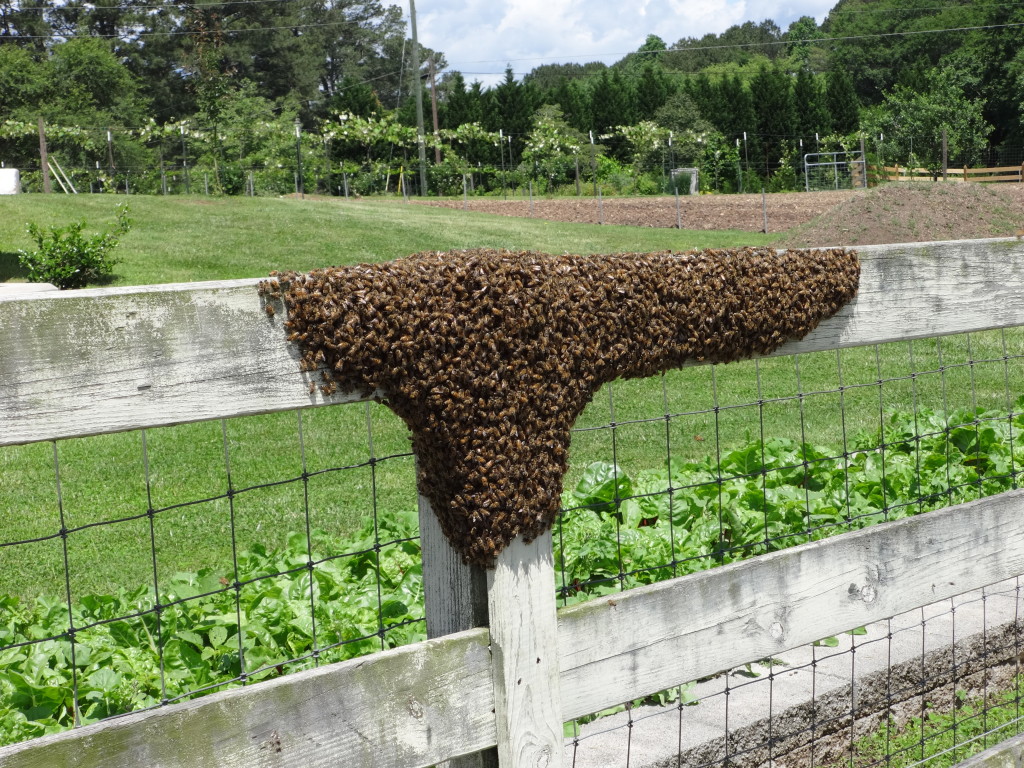Honeybees are among the most amazing miracles of a working farm. Cows eating a sunshine driven, regenerative food like grass and making such delicious milk, or pigs eating the scraps and left-overs from the whole farm and turning it into bacon are surely some of the more note-worthy homestead marvels. But the honey bee colony is a mind-numbing nebulous of life, and one of their most fascinating aspects popped up just the other day: a swarm of bees! If you didn’t know what was happening, it’s a bit frightening to look up and see a cloud filling the air with what looks like a violent, very upset group of airborne stingers. In reality though, a swarm is a very specific action and nothing about it is mad or angry. A hive that produces a swarm has simply run out of room, created a new queen, and the old queen must leave. She takes a great many of the worker bees with her to find a new home.
After a few minutes of aimless buzzing around the queen will find a place to gather and wait for worker bees to hunt for a new home. All the bees begin to rapidly gather around the queen wherever she lands – this is often on a bush or high up on a tree limb, but today the queen picked a fence post!
Nice and low to the ground at least. I’ve caught dozens of swarms and catching them in a five gallon bucket tied to the end of a 20’ pole is tricky! The idea is to capture the bees in a bucket, quickly put the lid on, and then literally pour the bees into an empty hive. When a swarm is on something fixed like a fence post, I just take a brush and sweep the bees in a great big ball right into my bucket.
Check out this little video of me sweeping the bees into my bucket, then placing them into their new hive:
This fence post was easy to get to, but the queen proved hard to get. It’s a good idea to get as many of the worker bees as you can in the bucket, but the only bee that matters is the queen. Once you put her in the empty hive, all the worker bees will follow her pheromone and in the matter of a half hour or so they’ll all end up in the new hive. I’ve managed to capture a few swarms in one grab, but this one must have taken me a dozen trips back and forth with my bucket to successfully capture the queen bee.
We’ll see how this new hive fairs. Ninety-nine percent of the time you won’t get any honey to harvest the first year from a swarm, but next year maybe we’ll rob a little of God’s amazing, insect produced goodness!



We had a swarm visit us last year and spend a couple of days in our holly tree and moved to our elm tree. Amazing sight.
I notice fewer bees these days because of all the insecticides used by growers and commercial farmers. Here is a great website providing those products to avoid in order to save our bees: http://www.xerces.org/wings-magazine/neonicotinoids-in-your-garden/
It’s sad to see the destruction of the honey bee; they’re so vital to all of agriculture!
Terrific video!
Hi David.
Kudos to the brave person on the camera filming this.
How did you recognize the Queen bee……….and where was she hiding in those dozen trips back and forth?
Bob: My wife has a good zoom on her camera, not much bravery about the bees! I’ve caught dozen’s of swarms, but I’ve only seen a queen bee in a swarm twice. You don’t have to see her, you just have to catch her. That’s sounds impossible but she’s usually in the thickest part of the swarm, so it’s just simple trial and error until you see all the worker bees leave the swarm for the new hive chasing a queen you caught but never saw!
Pingback: Happy New Year and 2014 in Pictures! |
I have noticed you don’t monetize doesyourcityhavecountryroads.com, don’t waste your traffic,
you can earn additional cash every month with new monetization method.
This is the best adsense alternative for any type of
website (they approve all websites), for more info simply search in gooogle: murgrabia’s tools